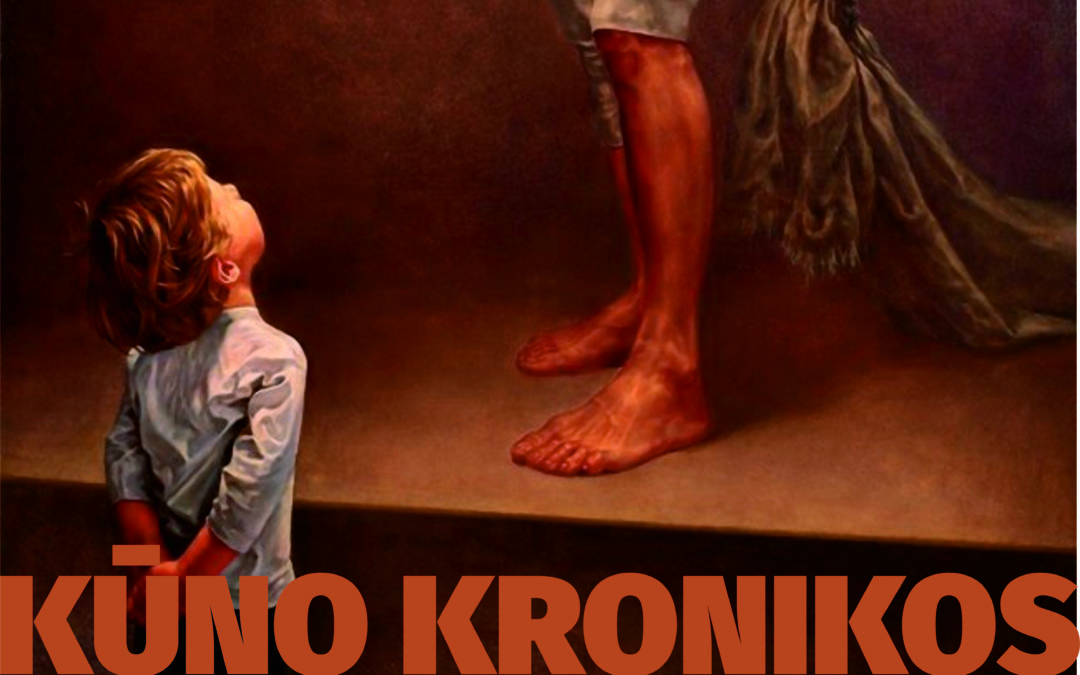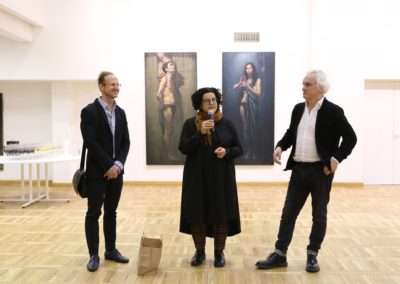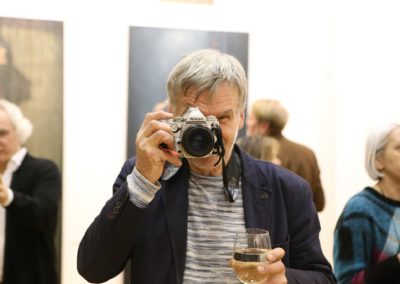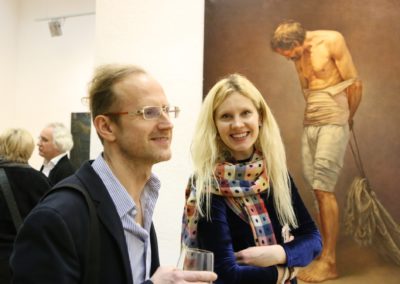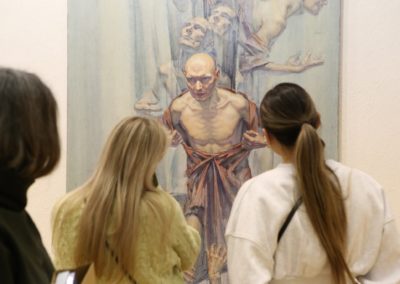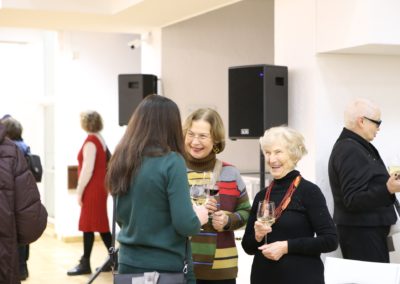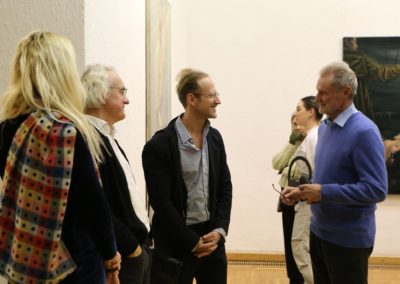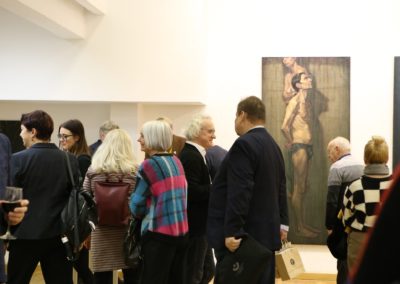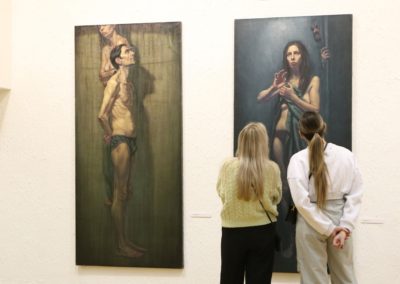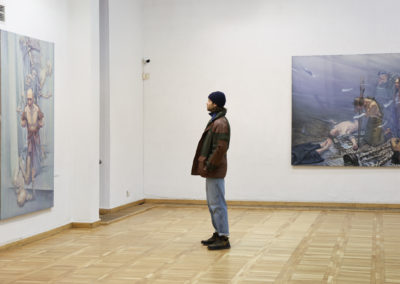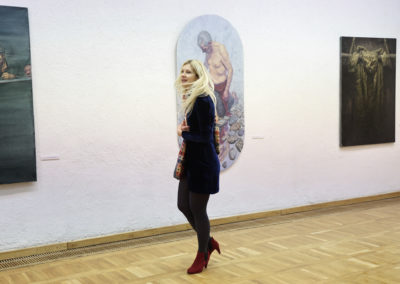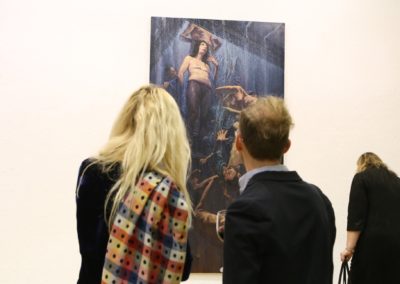Sausio 26 d., penktadienį, 17.00 val. atidaroma Pauliaus Juškos tapybos paroda „KŪNO KRONIKOS“.
Paroda veiks iki vasario 17 d.
[EN below]
KŪNO KRONIKOS
Mano paveikslai – paskirų tikrovės fragmentų samplaikos ir jų kompozicinės dėlionės. Domiuosi mus supančios aplinkos paviršiais ir formomis, iš pažiūros nereikšmingų daiktų ar gamtos motyvų išsidėstymo ritmika ar sugrupavimo netikėtumais. Ir visada tarp jų ieškau žmogaus, jo pėdsakų, jo veiklos užuominų ir jo paties kūno trajektorijų. Žmogus yra pagrindinis mano paveikslų veikėjas. Beveik visada tai realus asmuo, kurį nors šiek tiek pažįstu, ar bent esu kur nors matęs, kuris man įdomus charakteriu, taip pat kūno formomis. Pozuotoją pasitelkiu kaip aktorių, kuris padeda sukurti man tinkantį vaidmenį. Dažniausiai tai suvargęs, išsekęs, apiplyšęs, pusnuogis, šiek tiek išsigandęs ir pasimetęs asmuo. Savo esme tai eilinis, paprastas individas, netobulas, nešventas ir visai ne herojiškas. Bet šis eilinis tipas nėra tik kasdienę tikrovę išpažįstantis ir jos dėsniams paklūstantis žmogus. Jis visada šiek tiek dvilypis, jį kamuoja akistata su nežinomybe, kurios vengdamas, jis nuolat varžosi, gūžiasi, klumpa, arba ieško patogios ir saugios pozos .
Aš ir žaidžiu tomis pozomis. Iš jų gimsta situacijos ir pasakojimai. Domiuosi ne tik kūno formų reljefais, judesiais ar jų simbolika. Galvoju, ką ji kalba, kuo galima ją papildyti. Kartais tereikia pridėti keletą mažmožių ir piešiamas tipas virsta personažu, o paveiksle, kaip teatro scenoje, atsiranda veiksmo užuomazgos. Tačiau šios pozos ir vaidmenys man svarbios ne savaime, o kaip priemonė, kurianti įtampą tarp egzistencinės tikrovės ir fikcijos. Žmogus nori pridengti savo nuogumą ir bejėgiškumą, dėdamasis kuo kitu negu yra. Bet už kiekvieno vaidmens slypi tas pats tipas su visu savo silpnumu. Akistatoje su nežinoma tikrove, jo kūnas keliauja per tuos vaidmenis kartais su jais sutapdamas, kartais nutoldamas. Tai tartum kūno kronikos, persikūnijimai iš paveikslo į paveikslą, iš vieno laiko į kitą. Tai viename gyvenime telpantys kiti gyvenimai.
Žmogaus figūra kaitalioja pozas, bet jos formos ir proporcijos menkai kinta. Tapyti tas formas mane skatina keistas įsitikinimas, kad jų paviršiuose, tekstūrose ir apšvietime slypi tikrosios tiesos užuominos. Kūno apnuoginimas man reiškia tą atidengtą gyvenimo tikrovę, kurioje juntame ne tik žmogaus trapumą ir silpnumą bet ir amžinybės atšvaitus.
– Paulius Juška
APIE AUTORIŲ
Friday, January 26, 5:00 p.m. Paulius Juška’s painting exhibition „BODY CHRONICLES” opens.
The exhibition will be open until February 17.
CHRONICLES OF THE BODY
My paintings are combinations of individual fragments of reality and their compositional puzzles. I am interested in the surfaces and forms of the environment that surrounds us, the rhythmicity of arrangement or grouping of seemingly insignificant objects or natural motifs. And I always look for a person among them, his traces, hints of his activities and the trajectories of his own body. Man is the main character of my paintings. It is almost always a real person whom I know a little, or at least have seen somewhere, who is interesting to me in terms of character, as well as body shapes. I use the poser as an actor who helps me create a role that suits me. Most often, it is a tired, exhausted, torn, half-naked, slightly scared and lost person. In essence, he is an ordinary, simple individual, imperfect, unholy and not at all heroic. But this ordinary type is not just a person who confesses everyday reality and obeys its laws. He is always somewhat ambiguous, he is troubled by the confrontation with the unknown, avoiding which he is constantly competing, cowering, stumbling, or looking for a comfortable and safe pose.
I also play with those poses. Situations and stories are born from them. I am not only interested in reliefs of body shapes, movements or their symbolism. I think about what she says, what can be added to it. Sometimes it is only necessary to add a few little ones and the type being drawn turns into a character, and the beginnings of action appear in the picture, like on a theater stage. But these poses and roles are not important to me in themselves, but as a means of creating a tension between existential reality and fiction. Man wants to cover his nakedness and helplessness by pretending to be something other than what he is. But behind each role lies the same type with all its weakness. In the confrontation with the unknown reality, his body travels through those roles, sometimes overlapping with them, sometimes moving away. These are, as it were, chronicles of the body, reincarnations from picture to picture, from one time to another. It is other lives that fit into one life.
The human figure alternates poses, but its shape and proportions change little. What drives me to paint those forms is the strange belief that their surfaces, textures and lighting hold hints of real truth. For me, exposing the body means the revealed reality of life, where we feel not only human fragility and weakness, but also reflections of eternity.
– Paulius Juška
ABOUT THE AUTHOR
Paulius Juška was born in 1975. 1997 graduated from the Vilnius Academy of Arts. Since 1994 participates in exhibitions in Lithuania and abroad (United States, Denmark). He has held individual exhibitions in Vilnius (1996, 1999, 2002, 2004, 2005, 2008, 2013), Klaipėda (2003), Palanga (2012). P. Juška’s painting is characterized by means of expression of academic realism, careful modeling of forms. In his work, he tries to reflect social phenomena, the main theme is poverty, loneliness, decline; he chooses destitute old men, drunkards, homeless and vagabonds as models (Vyro akts, Prie draperijas, both 2003), single objects (Still Life with Bread 2005, Firewood 2006, Burokas 2007). He painted works with biblical scenes (Sūnus palalidūnas 2004, Auka 2006), religious compositions (Apparition of the Holy Virgin Mary 2001, in the Church of the Assumption of the Virgin Mary in Šimonii). The works are characterized by a masterful rendering of the likeness of the subjects and the texture of the objects. Some of the works are owned by the Museum of MO in Vilnius.

